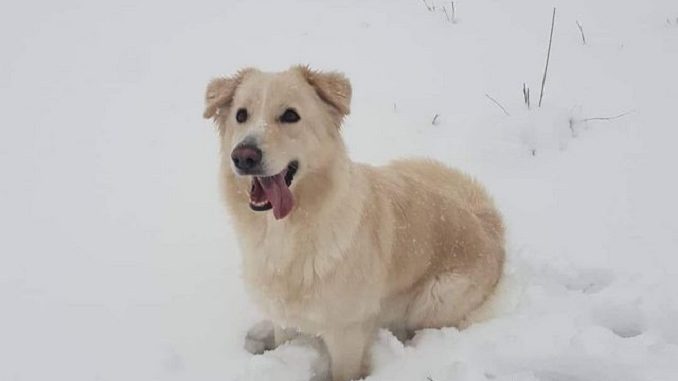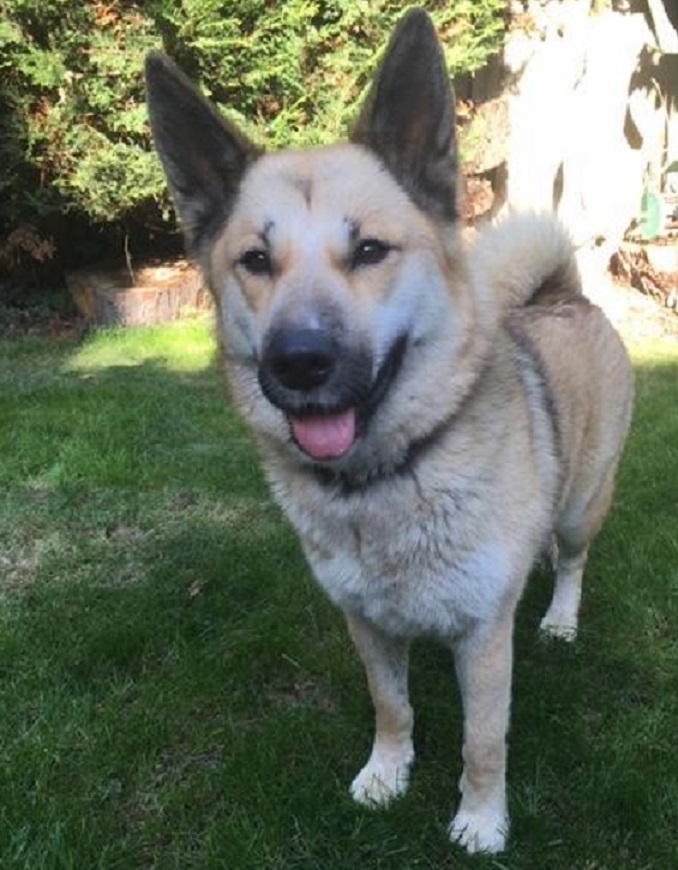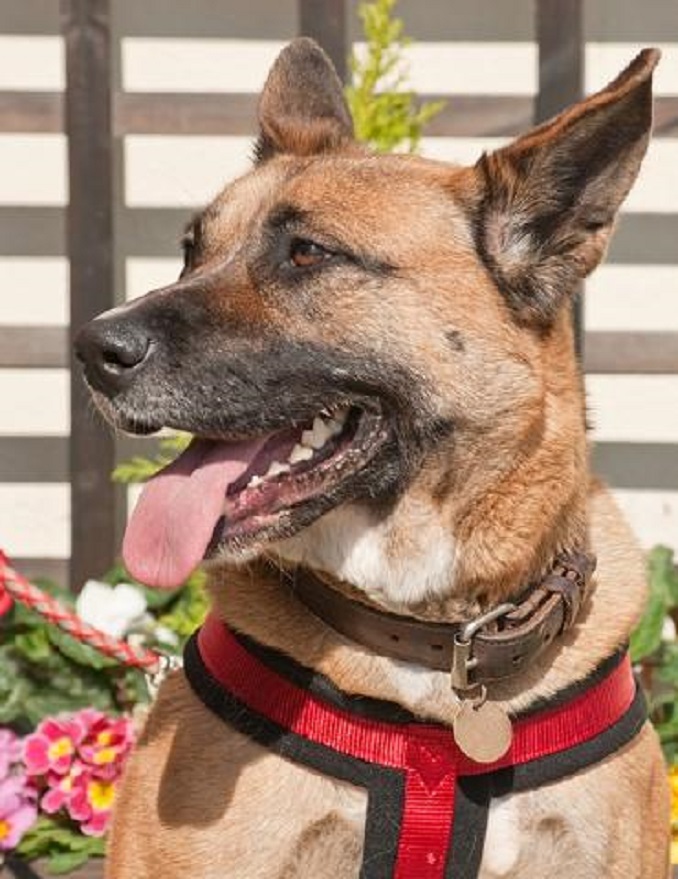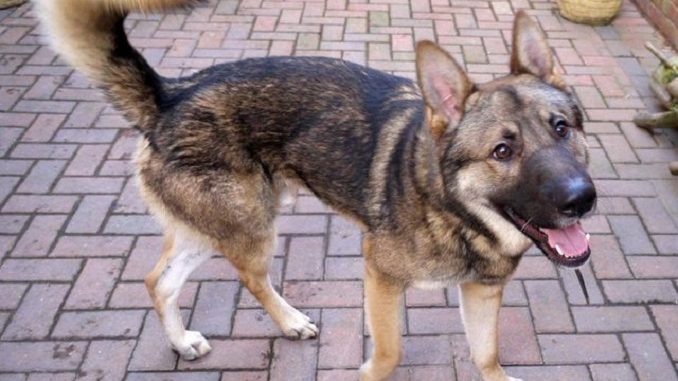Imagine a dog with the dignified poise of an Akita and the unwavering loyalty of a German Shepherd. Intriguing, right? That’s the Akita German Shepherd Mix, also called Shepkita. From the first moment I encountered this blend, I was captivated. Their striking appearance and noble aura are simply unmatched.
This mix isn’t just another pet. They’re a story waiting to unfold in your life. If you’re considering bringing one into your home, you’re on the cusp of an extraordinary adventure. Let’s peel back the layers and explore the unique characteristics that make the Akita German Shepherd Mix an unforgettable companion.
TABLE OF CONTENTS
- Akita German Shepherd Mix Quick Breed Summary
- Origin of the Shepkita
- Akita Shepherd's Physical Appearance
- Akita German Shepherd Mix Personality and Temperament
- Taking Care of a German Shepherd Akita Mix
- How to Train a Shepkita
- The Most Common Health Concerns for Shepkitas
- The Cost of Owning an Akita German Shepherd Mix
- FAQs: More About Akita German Shepherds
- So, Is the Akita German Shepherd Mix Good for You?
Akita German Shepherd Mix Quick Breed Summary
Origin of the Shepkita
From Adobe Stock
Delving into the Shepkita’s roots, we uncover a tale of two storied breeds coming together. This hybrid is relatively new to the scene, but its lineage is rich with history and purpose.
The Akita: A Japanese Legacy
The Akita’s story begins in Japan, a large breed revered for its nobility and loyalty. Originally bred for hunting and guarding, Akitas are symbols of strength and protection. They’re known for their unwavering loyalty. Perhaps, the most popular from this breed is Hachiko, the loyal Akita who waited for his owner every day, even after his owner’s death.
Akitas carry with them the essence of the samurai—courage, dignity, and fidelity. Their imposing stature and bear-like appearance were developed over centuries in the rugged terrains of northern Japan. They are adept guardians and resilient companions.
The German Shepherd: A German Icon
On the other side, we have the German Shepherd, a breed that epitomizes versatility and intelligence. Originating from Germany in the late 19th century, these dogs were bred for herding and protecting livestock. However, their remarkable intelligence and adaptability quickly made them a favorite for various roles, from police and military work to assistance and therapy jobs.
German Shepherds are known for their courage, loyalty, and keen sense of duty. Their athletic build and keen intellect have made them one of the most popular and respected breeds worldwide. They embody a perfect balance of strength and agility, coupled with an unwavering commitment to their human companions.
The Birth of the Shepkita
The Shepkita doesn’t have a ‘created’ moment like some designer breeds. Instead, this mix likely came about from a natural blend of these two distinguished breeds. The aim? To combine the Akita’s dignified strength with the German Shepherd’s versatile intelligence.
While not bred with a specific purpose in mind, the Shepkita inherits the best of both worlds. From the Akita, it gets its formidable presence and unwavering loyalty. From the German Shepherd, it inherits intelligence, versatility, and an eagerness to please. This mix is for those who admire the traits of both parent breeds and seek a companion with a unique blend of characteristics.
Akita Shepherd’s Physical Appearance
From Adobe Stock
Diving into the world of Akita Shepherds, their physical presence is the first thing you notice. It’s like they walk in with a story, their appearance a blend of nobility and resilience. Every feature, from their stance to their coat, speaks volumes.
Let’s break it down and see what makes them stand out.
Height and Weight
When it comes to height, these dogs are like the gentle giants of the hybrid world. Males can reach up to 28 inches, commanding attention with their size. Females, a tad shorter, still stand tall with grace. And their weight? They’re solid, ranging from 75 to 120 pounds. It’s all muscle and power, a testament to their strong heritage.
In terms of build, the Akita Shepherd is robust. They’re not just tall. They’re well-proportioned, blending the Akita’s sturdy frame with the German Shepherd’s athletic build. This mix results in a dog that’s both imposing and agile, ready for action at any moment.
Coat and Colors
Their coat is a marvel in itself. Thick and dense, it’s designed to protect them in all kinds of weather. The texture? It’s a bit of both parents—somewhere between the Akita’s harsh coat and the German Shepherd’s smoother one. And the colors? They’re a canvas of nature’s best. From the deep blacks and tans of the German Shepherd to the striking brindles and whites of the Akita, they wear their heritage with pride.
But it’s not just about warmth; the coat also adds to their majestic look. Whether it’s the way the sun catches the hues or the way it flows as they move, their coat is an integral part of their charm. Each Akita Shepherd is a unique blend, no two coats are the same, making every one of them a one-of-a-kind companion.
Other Physical Features
Looking into their eyes, you see the soul of the Akita Shepherd. Deep and expressive, they convey a world of emotions, from curiosity to loyalty. And their face—a perfect blend of strength and intelligence. The Akita’s broad features combined with the German Shepherd’s alertness give them a look that’s both wise and ready for anything.
Their stature is another point of pride. Standing tall and confident, they exude a sense of security and companionship. It’s not just their size but the way they carry themselves—with a mix of dignity and readiness that’s truly captivating. This, combined with their unique facial expressions and body language, makes the Akita Shepherd a remarkable presence in any setting.
Akita German Shepherd Mix Personality and Temperament
From Adobe Stock
Talking about the Shepkita’s personality is like opening a treasure chest. Every trait is a gem. Let’s dive in.
Loyal and Protective
First up, loyalty. These dogs are like your shadow. Always there, always watching. Their protective streak? Unmatched. They’re not just pets. They’re guardians of their family. It’s in their DNA, a blend of the Akita’s watchful eye and the German Shepherd’s protective nature.
But don’t think they’re all serious. Once they know you’re part of the pack, their softer side emerges. They become the most devoted companions. It’s a loyalty that’s deep and unwavering, a testament to their ancestral lineage.
Intelligent and Trainable
Now, intelligence. Shepkitas are sharp. I mean, really sharp. Training them? It’s a breeze, mostly. Their German Shepherd side loves to learn, always eager to please. But remember, they’ve got a bit of Akita stubbornness. Patience is key.
Their intelligence isn’t just about tricks and commands. It’s about understanding. They’re adept at reading situations and sensing moods. This makes them not just trainable but truly empathetic companions. It’s a joy to see them in action, solving problems and adapting with ease.
Independent Yet Affectionate
Yes, they can be a bit headstrong. It’s part of their charm. But don’t mistake this for aloofness. Given time, they’ll shower you with affection. It’s a deep, meaningful bond that forms over time.
Their affection is earned, not given away lightly. Once you’re in their heart, it’s for good. They’ll stick by you, offering comfort and companionship like no other. It’s this mix of independence and affection that makes them such fascinating and rewarding companions.
Taking Care of a German Shepherd Akita Mix
Caring for a Shepkita, while a challenge, is an incredibly rewarding experience. It requires attention to detail and a deep understanding of their needs.
Feeding: Nutritional Balance Is Key
Feeding a Shepkita is about finding the right balance. These dogs are powerhouses, needing ample nutrition to match their size and energy. Opt for high-quality dog food, rich in lean proteins to support muscle health. But balance is crucial. Incorporate vegetables and grains for a well-rounded diet.
And portion control? Non-negotiable. Overfeeding can lead to obesity, especially if their exercise routine is lacking.
Consistency in feeding times helps regulate their metabolism and energy levels. Morning and evening meals are a good rhythm.
I’d also like to emphasize the importance of hydration. Fresh, clean water available 24/7 is vital for their overall health.
Grooming: Beyond Just Aesthetics
Grooming a Shepkita isn’t just about keeping them looking good; it’s about health.
Their dense coats require regular grooming to prevent matting and to manage shedding. A thorough brush a few times a week minimizes loose hair and stimulates their skin.
But grooming isn’t just about the coat. Regular nail trims, ear cleaning, and dental care are crucial to prevent common health issues.
Bath time should be an occasional affair, using a mild dog shampoo to protect their skin’s natural oils. It’s a great opportunity to check for any skin issues or bumps that might need a vet’s attention.
Exercise: More Than Just Physical Activity
Exercise for a Shepkita goes beyond physical health; it’s about mental well-being too. These dogs have a tank of energy that needs to be expended. Daily, vigorous walks or runs are essential. But vary the routine. Hikes, swimming, and fetch can break the monotony and keep them engaged.
Remember, a tired Shepkita is a happy Shepkita. It’s not just about tiring them out physically but providing an outlet for their natural instincts and intelligence.
Mental Stimulation: Engage the Mind
Don’t underestimate the intelligence of this breed. They crave mental stimulation as much as physical exercise.
Puzzle toys, interactive games, and regular training sessions keep their minds sharp. It also helps prevent destructive behaviors borne out of boredom.
Incorporate training into playtime. It reinforces your bond and keeps their cognitive skills in tip-top shape. Remember, mental exercise can tire them out just as much as physical activity, so balance is key.
How to Train a Shepkita
Training a Shepkita is an adventure in patience, understanding, and consistency. With their blend of intelligence and independence, they respond best to training that’s engaging and respectful.
Start Early and Be Consistent
- Early Socialization: Begin socializing your Shepkita as early as possible. Expose them to different people, pets, and environments. It helps them become well-adjusted adults.
- Consistency Is Key: Stick to a routine. Consistent commands, rewards, and consequences make training clearer for your Shepkita.
Use Positive Reinforcement
- Rewards Work Wonders: Shepkitas respond brilliantly to positive reinforcement. Use treats, praise, and play as rewards.
- Avoid Punishment: Negative methods can damage your bond. Focus on rewarding good behavior instead of punishing the bad.
Keep Training Sessions Short and Sweet
- Short Sessions: Their attention spans can be short. Keep training sessions brief but frequent, ideally 10-15 minutes.
- Fun and Engaging: Turn training into a game. It keeps their interest peaked and makes learning enjoyable.
Focus on Basic Commands First
- Start with the Basics: “Sit,” “Stay,” “Come,” “Heel.” These foundational commands are crucial for their safety and your peace of mind.
- Get More Intense: Gradually increase the complexity of commands as they master the basics.
Be Patient and Adjust Your Approach as Needed
- Patience Pays Off: Shepkitas can be stubborn. If a method isn’t working, try a different approach rather than getting frustrated.
- Stay Positive: Your attitude influences their learning. Stay upbeat and patient, even when progress seems slow.
Address Behavioral Challenges Early
- Barking and Guarding: Shepkitas can be vocal and protective. Teach them when it’s appropriate to bark or guard.
- Leash Training: Given their size and strength, leash manners are essential. Start leash training early to prevent pulling and tugging.
The Most Common Health Concerns for Shepkitas
Understanding the health challenges Shepkitas may face is key to their well-being.
Hip and Elbow Dysplasia
This condition occurs when the hip or elbow joints fail to develop properly, often leading to arthritis. It can be genetic and may be worsened by factors like improper weight or rapid growth. Symptoms include difficulty standing up, limping after exercise, and a reluctance to jump or climb.
- Keep your Shepkita at a healthy weight to minimize pressure on the joints.
- Opt for low-impact exercises that don’t strain the joints, like swimming.
- Consider supplements like glucosamine and chondroitin, under vet guidance.
- Provide a comfortable resting area with orthopedic bedding to support the joints.
- Schedule regular vet visits for early detection and management strategies.
Bloat (Gastric Dilatation-Volvulus)
Bloat is a critical condition where the stomach fills with gas and can twist on itself, cutting off blood flow. It’s more common in large, deep-chested breeds. Symptoms include a swollen abdomen, distress, drooling, and attempts to vomit without bringing anything up.
- Feed your Shepkita smaller, more frequent meals to prevent overeating.
- Avoid exercise immediately before and after meals to let digestion occur.
- Consider a slow-feeder bowl to reduce air intake while eating.
- Keep an eye out for early symptoms and know where your nearest emergency vet is.
- Discuss preventive surgery options with your vet if your Shepkita is at high risk.
Thyroid Issues
Thyroid issues, particularly hypothyroidism, occur when the thyroid gland doesn’t produce enough hormones, affecting metabolism. It’s common in middle-aged dogs and can lead to weight gain, lethargy, and changes in coat and skin condition.
- Regular blood tests can monitor thyroid levels.
- Thyroid hormone replacement therapy, as prescribed by a vet, can manage the condition.
- Monitor your dog’s weight and adjust diet and exercise accordingly.
- Keep an eye on skin and coat health, addressing any changes promptly.
- Regular vet visits are crucial for ongoing management and dosage adjustments.
Eye Problems
Shepkitas can inherit various eye conditions like cataracts or progressive retinal atrophy, leading to impaired vision or blindness. Symptoms include cloudiness in the eyes, bumping into objects, or reluctance to go into dark spaces.
- Schedule annual eye exams with a veterinary ophthalmologist.
- Protect your dog’s eyes from harsh light and debris.
- Antioxidant-rich diets may help maintain eye health.
- Be attentive to changes in your dog’s vision or eye appearance.
- Early intervention can prevent or slow down the progression of some eye diseases.
Skin Allergies
Skin allergies in Shepkitas can result from environmental allergens, food, or fleas, leading to itching, redness, and secondary infections. Symptoms include excessive scratching, licking, and patches of missing fur.
- Identify and eliminate the allergen source, if possible.
- Regular flea prevention is crucial to rule out flea allergy dermatitis.
- Special hypoallergenic diets can help manage food allergies.
- Medicated shampoos and supplements like omega-3 fatty acids can support skin health.
- Consult with your vet for appropriate allergy medications and treatments.
Cardiovascular Problems
Heart diseases, including conditions like dilated cardiomyopathy, affect the heart’s ability to pump blood effectively. This can lead to a reduced flow of oxygen and nutrients throughout the body. Symptoms can include coughing, difficulty breathing, lethargy, and in more severe cases, fainting or collapse.
- Regular veterinary check-ups to monitor heart health.
- A balanced diet and controlled exercise regimen.
- Medications as prescribed by your vet can manage symptoms and improve quality of life.
- Monitor your dog for signs of heart failure, such as coughing and fatigue.
- Consider dietary supplements that support heart health, under veterinary guidance.
The Cost of Owning an Akita German Shepherd Mix
Owning a Shepkita involves various expenses, from initial costs to ongoing care. Let’s break down the financial commitment required.
Initial Costs
- Purchase Price: Depending on the breeder’s reputation and the puppy’s lineage, prices can range from $300 to $800.
- Initial Veterinary Visits: First vaccinations, health screenings, and possibly spaying/neutering can add up to $200-$300.
- Supplies: Beds, crates, leashes, collars, and food and water bowls can total around $200-$500, depending on quality.
Ongoing Monthly Expenses
- Food: High-quality dog food suited to large breeds costs about $60-$100 per month.
- Routine Veterinary Care: Annual check-ups, vaccinations, and routine tests can average $200-$300 a year, roughly $20-$25 monthly.
- Flea, Tick, and Heartworm Prevention: Monthly preventatives can cost $20-$40.
- Pet Insurance: To offset unexpected medical expenses, monthly premiums can range from $30 to $50.
Additional and Unexpected Costs
- Emergency Veterinary Care: Accidents or illnesses can lead to significant costs, easily reaching $500-$2000 for serious issues.
- Training: Professional training sessions, if opted for, can range from $50 to $100 per hour.
- Grooming: Regular grooming, if not done at home, can cost $30-$90 per session, depending on the services.
FAQs: More About Akita German Shepherds
How long do Akita German Shepherds live?
Akita German Shepherds, or Shepkitas, typically have a lifespan of 10 to 13 years. This can vary based on genetics, lifestyle, and the level of care they receive, including diet, exercise, and regular veterinary check-ups.
Do Shepkitas bark a lot?
Shepkitas can be vocal, but they don’t necessarily bark more than other breeds. Their barking is usually purposeful, such as alerting strangers or when they’re particularly excited or stressed. Proper training and socialization can help manage excessive barking.
Is the Akita Shepherd a good family dog?
The Akita Shepherd can be a great family dog with proper training and socialization. They’re known for their loyalty and protective nature. However, due to their size and strength, supervision around small children is advisable to ensure safe interactions.
Are Akita German Shepherds good with children?
With the right socialization, Akita German Shepherds can be good with children. They are protective and can be gentle companions. However, their large size and strong personality mean that interactions should always be supervised, especially with younger children.
Can Akita Shepherds live with other pets?
Akita Shepherds can live with other pets if they are raised together or properly introduced. Early socialization is key. Their strong prey drive means careful introductions and ongoing supervision are necessary, especially with smaller animals.
So, Is the Akita German Shepherd Mix Good for You?
The Shepkita, a majestic blend of the Akita and German Shepherd, boasts a remarkable set of qualities. With their imposing stature, dense coat, and expressive eyes, they command attention. But it’s not just their appearance that’s captivating; their personalities are equally compelling. Known for their intelligence, loyalty, and protective nature, Shepkitas make for dedicated companions.
Akita Shepherds Are For
- Active Individuals or Families: If you lead an active lifestyle and enjoy outdoor activities, a Shepkita could be a perfect match. They thrive on exercise and adventure.
- Experienced Dog Owners: Those with prior experience in handling large, strong-willed breeds will find a rewarding companion in a Shepkita.
- Those Looking for a Loyal Guard Dog: Their protective nature makes them excellent guard dogs, always on alert for their family.
- Homeowners with Space: Ideally, they need a home with a yard for them to roam and expend energy.
Akita Shepherds Are Not For
- First-Time Dog Owners: Their size, strength, and personality might be challenging for someone without prior dog training experience.
- Apartment Dwellers: Limited space can be challenging for a breed that requires lots of exercise and mental engagement.
- Families with Very Small Children: Due to their size and strength, interactions with small children should always be supervised.
- Those with Limited Time: Shepkitas need time and attention for exercise, training, and bonding.
Photos in this post via dogsblog.com — a website that helps rehome dogs.





Be the first to comment